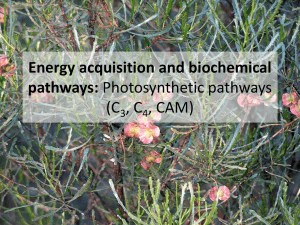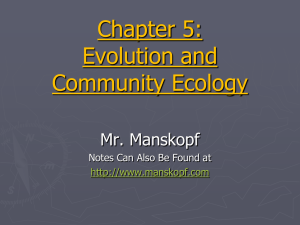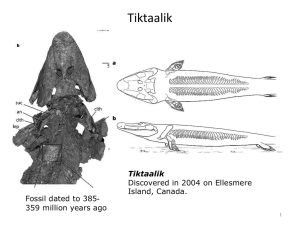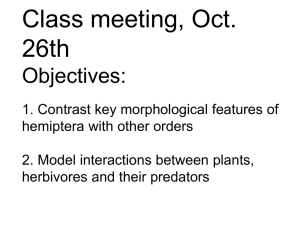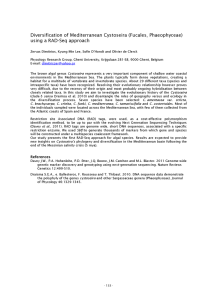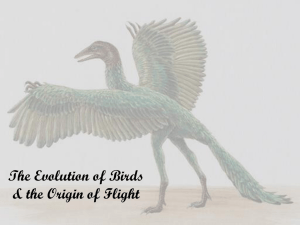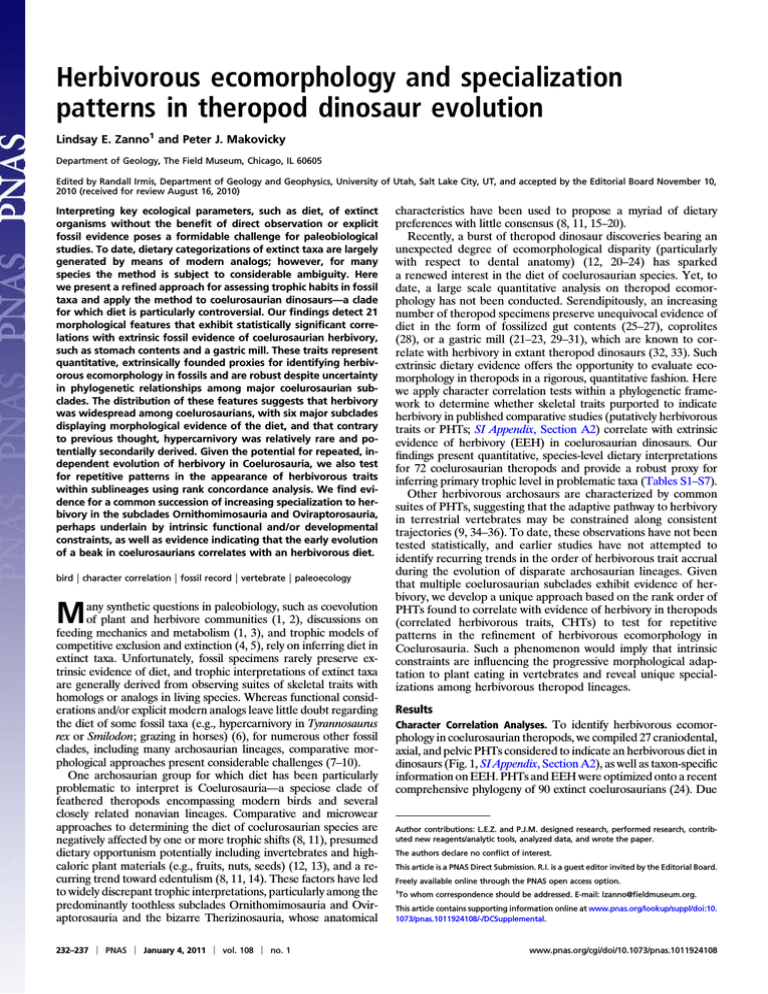
Herbivorous ecomorphology and specialization
patterns in theropod dinosaur evolution
Lindsay E. Zanno1 and Peter J. Makovicky
Department of Geology, The Field Museum, Chicago, IL 60605
Edited by Randall Irmis, Department of Geology and Geophysics, University of Utah, Salt Lake City, UT, and accepted by the Editorial Board November 10,
2010 (received for review August 16, 2010)
Interpreting key ecological parameters, such as diet, of extinct
organisms without the benefit of direct observation or explicit
fossil evidence poses a formidable challenge for paleobiological
studies. To date, dietary categorizations of extinct taxa are largely
generated by means of modern analogs; however, for many
species the method is subject to considerable ambiguity. Here
we present a refined approach for assessing trophic habits in fossil
taxa and apply the method to coelurosaurian dinosaurs—a clade
for which diet is particularly controversial. Our findings detect 21
morphological features that exhibit statistically significant correlations with extrinsic fossil evidence of coelurosaurian herbivory,
such as stomach contents and a gastric mill. These traits represent
quantitative, extrinsically founded proxies for identifying herbivorous ecomorphology in fossils and are robust despite uncertainty
in phylogenetic relationships among major coelurosaurian subclades. The distribution of these features suggests that herbivory
was widespread among coelurosaurians, with six major subclades
displaying morphological evidence of the diet, and that contrary
to previous thought, hypercarnivory was relatively rare and potentially secondarily derived. Given the potential for repeated, independent evolution of herbivory in Coelurosauria, we also test
for repetitive patterns in the appearance of herbivorous traits
within sublineages using rank concordance analysis. We find evidence for a common succession of increasing specialization to herbivory in the subclades Ornithomimosauria and Oviraptorosauria,
perhaps underlain by intrinsic functional and/or developmental
constraints, as well as evidence indicating that the early evolution
of a beak in coelurosaurians correlates with an herbivorous diet.
bird
| character correlation | fossil record | vertebrate | paleoecology
M
any synthetic questions in paleobiology, such as coevolution
of plant and herbivore communities (1, 2), discussions on
feeding mechanics and metabolism (1, 3), and trophic models of
competitive exclusion and extinction (4, 5), rely on inferring diet in
extinct taxa. Unfortunately, fossil specimens rarely preserve extrinsic evidence of diet, and trophic interpretations of extinct taxa
are generally derived from observing suites of skeletal traits with
homologs or analogs in living species. Whereas functional considerations and/or explicit modern analogs leave little doubt regarding
the diet of some fossil taxa (e.g., hypercarnivory in Tyrannosaurus
rex or Smilodon; grazing in horses) (6), for numerous other fossil
clades, including many archosaurian lineages, comparative morphological approaches present considerable challenges (7–10).
One archosaurian group for which diet has been particularly
problematic to interpret is Coelurosauria—a speciose clade of
feathered theropods encompassing modern birds and several
closely related nonavian lineages. Comparative and microwear
approaches to determining the diet of coelurosaurian species are
negatively affected by one or more trophic shifts (8, 11), presumed
dietary opportunism potentially including invertebrates and highcaloric plant materials (e.g., fruits, nuts, seeds) (12, 13), and a recurring trend toward edentulism (8, 11, 14). These factors have led
to widely discrepant trophic interpretations, particularly among the
predominantly toothless subclades Ornithomimosauria and Oviraptorosauria and the bizarre Therizinosauria, whose anatomical
232–237 | PNAS | January 4, 2011 | vol. 108 | no. 1
characteristics have been used to propose a myriad of dietary
preferences with little consensus (8, 11, 15–20).
Recently, a burst of theropod dinosaur discoveries bearing an
unexpected degree of ecomorphological disparity (particularly
with respect to dental anatomy) (12, 20–24) has sparked
a renewed interest in the diet of coelurosaurian species. Yet, to
date, a large scale quantitative analysis on theropod ecomorphology has not been conducted. Serendipitously, an increasing
number of theropod specimens preserve unequivocal evidence of
diet in the form of fossilized gut contents (25–27), coprolites
(28), or a gastric mill (21–23, 29–31), which are known to correlate with herbivory in extant theropod dinosaurs (32, 33). Such
extrinsic dietary evidence offers the opportunity to evaluate ecomorphology in theropods in a rigorous, quantitative fashion. Here
we apply character correlation tests within a phylogenetic framework to determine whether skeletal traits purported to indicate
herbivory in published comparative studies (putatively herbivorous
traits or PHTs; SI Appendix, Section A2) correlate with extrinsic
evidence of herbivory (EEH) in coelurosaurian dinosaurs. Our
findings present quantitative, species-level dietary interpretations
for 72 coelurosaurian theropods and provide a robust proxy for
inferring primary trophic level in problematic taxa (Tables S1–S7).
Other herbivorous archosaurs are characterized by common
suites of PHTs, suggesting that the adaptive pathway to herbivory
in terrestrial vertebrates may be constrained along consistent
trajectories (9, 34–36). To date, these observations have not been
tested statistically, and earlier studies have not attempted to
identify recurring trends in the order of herbivorous trait accrual
during the evolution of disparate archosaurian lineages. Given
that multiple coelurosaurian subclades exhibit evidence of herbivory, we develop a unique approach based on the rank order of
PHTs found to correlate with evidence of herbivory in theropods
(correlated herbivorous traits, CHTs) to test for repetitive
patterns in the refinement of herbivorous ecomorphology in
Coelurosauria. Such a phenomenon would imply that intrinsic
constraints are influencing the progressive morphological adaptation to plant eating in vertebrates and reveal unique specializations among herbivorous theropod lineages.
Results
Character Correlation Analyses. To identify herbivorous ecomorphology in coelurosaurian theropods, we compiled 27 craniodental,
axial, and pelvic PHTs considered to indicate an herbivorous diet in
dinosaurs (Fig. 1, SI Appendix, Section A2), as well as taxon-specific
information on EEH. PHTs and EEH were optimized onto a recent
comprehensive phylogeny of 90 extinct coelurosaurians (24). Due
Author contributions: L.E.Z. and P.J.M. designed research, performed research, contributed new reagents/analytic tools, analyzed data, and wrote the paper.
The authors declare no conflict of interest.
This article is a PNAS Direct Submission. R.I. is a guest editor invited by the Editorial Board.
Freely available online through the PNAS open access option.
1
To whom correspondence should be addressed. E-mail: lzanno@fieldmuseum.org.
This article contains supporting information online at www.pnas.org/lookup/suppl/doi:10.
1073/pnas.1011924108/-/DCSupplemental.
www.pnas.org/cgi/doi/10.1073/pnas.1011924108
Rank Concordance Analysis. To investigate common patterns of
Fig. 1. Select cranial traits appearing in multiple lineages of coelurosaurian
theropod dinosaurs tested herein as PHTs. Ecomorphological indicators
statistically correlated with extrinsic evidence of herbivory (first- and secondorder CHTs) are marked with an asterisk. Traits featured on six species representing four coelurosaurian theropod subclades, including the only predominantly folivorous modern bird. (A) Opisthocomus hoazin skull, left lateral
view (extant Aves), adapted from http://digimorph.org/. Extinct theropods: (B)
Ornithomimus edmontonicus (RTMP 95.110.1) skull, left lateral view (derived
Ornithomimosauria); (C) Shenzhousaurus orientalis (NGMC 977–4-002) skull,
left oblique dorsolateral view (primitive Ornithomimosauria), adapted from
ref. 21; (D) Incisivosaurus gauthieri (IVPP V13326) skull left lateral view
(primitive Oviraptorosauria); and (E) Caenagnathus collinsi (CMN 8776) fused
lower mandibles, dorsal view (derived Oviraptorosauria; Table S7, and see SI
Appendix, Section A3 for trait descriptions.
to the rarity of extrinsic evidence of diet associated with fossil
remains, only 22% of the taxa considered could be assigned to
a trophic category a priori. Nonetheless, extrinsic evidence of diet
was distributed across the phylogeny, occurring in all major subclades (except Therizinosauria and Alvarezsauroidea) and two
outgroup taxa (Fig. 2A and Table S1).
To detect correlation between PHTs and EEH, we used three
different statistical techniques for examining character correlations
on phylogenies: concentrated changes test (37), pairwise comparZanno and Makovicky
herbivorous trait accrual during the evolution of theropods, we
ranked the order of appearance of CHTs with independent originations in the herbivorous coelurosaurian subclades Ornithomimosauria, Therizinosauria, and Oviraptorosauria under multiple
optimization techniques (Fig. 2B and Materials and Methods). We
excluded birds because few CHTs were found to optimize at ancestral avian nodes. Of the 21 CHTs recovered in our study,
a maximum of eight were consistent with this parameter and could
be tested for congruence. Here again we tested alternate tree topologies to investigate multiple phylogenetic hypotheses (Materials
and Methods).
We found no statistical significance in the order of CHTs acquisition among all three nonavian herbivorous lineages under
any of our optimization methods and tree topologies. However,
when we compared ornithomimosaurians and oviraptorosaurians
alone we found the pattern of trait accrual among 5–8 CHTs to
be significant (P value 0.05–0.005) under iterations involving all
three optimization techniques (Fig. 1B; see SI Appendix, Section
B4, for CHT descriptions). The lack of significance between the
sequences of CHT accrual in all three theropod lineages may
relate to methodological problems such as missing data, causing
widely discrepant character rankings and the low number of
traits appearing with independent origins in all three subclades
(three to four in some optimizations), or genuine differences in
the refinement of ecomorphological traits that indicate unique
patterns of specialization, as discussed in the following section.
PNAS | January 4, 2011 | vol. 108 | no. 1 | 233
EVOLUTION
isons (38), and Discrete (39) (Materials and Methods and SI Appendix, Section A6). We tested over 2,600 individual trait pairings,
encompassing multiple iterations reflecting current uncertainties in
coelurosaurian subclade relationships and character codes for incipiently developed states (SI Appendix, Section B2) (3). Each test
produced variable clusters of correlative PHTs. We then contrasted
results between the three tests and compiled a common suite of
PHTs that were significantly correlated (P < 0.05) in all three tests
(CHTs). Traits with significant correlations in concentrated
changes tests and/or Discrete, yet not achieving significance using
pairwise comparisons were evaluated to determine whether the
discrepancy could be attributed to the inability of the pairwise test
to achieve statistical significance with low trait-change frequencies
(Materials and Methods). Insignificant pairwise comparisons were
not used to reject CHTs if the number of independent transformations fell below the threshold for significance and results included iterations in which all possible pairings showed a coincident
change in both traits.
We consider CHTs as first-order correlates if they achieve
significance when tested directly against EEH. However, given
the limited occurrence of EEH in our study, we also used firstorder correlates as proxy data to test for additional correlations
between remaining PHTs. PHTs possessing correlations with
first-order traits are considered as second-order CHTs. Although
we detected third- through fifth-order correlations in our analyses, and these patterns are valuable in identifying trait correlations in theropods, we deem these features as too many steps
removed from primary EEH observations to be reliable herbivorous indicators.
Despite the low incidence of EEH across the sampled diversity,
we detected significant first- and second-order correlations between EEH and 21 of 27 PHTs purported as ecomorphological
indicators of herbivory in dinosaurs (Fig. 1 and Table S7; see SI
Appendix, Section B1, for results by test). The evolution of dentary
concavity, conical-subconical teeth, tooth symmetry, and loss of
ziphodonty (Fig. 1) possess the strongest correlation with EEH
under multiple methods (P values 0.0006–0.01). Rostral projection
of the dentary symphysis, ventral deflection of the dentary symphysis producing a rostral gap, and progressive tooth loss are also
highly correlative (P values 0.008–0.05).
Limusaurus inextricabilis
Allosaurus fragilis
Sinraptor dongi
Tyrannosauroidea
Compsognathidae
Harpymimus okladnikovi
Shenzhousaurus orientalis
Pelecanimimus polydon
Garudimimus brevipes
Archaeorn. asiaticus
Sinornithomimus dongi
Gallimimus bullatus
Struthiomimus altus
Ornitho. edmontonicus
Anserimimus planinychus
Ornitholestes hermanni
Falcarius utahensis
Beipiaosaurus inexpectus
Alxasaurus elesitaiensis
Erliansaurus bellamanus
Neimongosaurus yangi
Nothronychus mckinleyi
Nanshiungo. brevispinus
Segnosaurus galbinensis
Erlikosaurus andrewsi
Patagonykus puertai
Mononykus olecranus
Shuvuuia deserti
Oviraptor philoceratops
Avimimus portentosus
Caenagnathus collinsi
Chirostenotes pergracilis
Citipati osmolskae
Rinchenia mongoliensis
Khann mckennai
Conchoraptor gracilis
Heyuannia huangi
Ingenia yanshani
Microvenator celer
Caudipteryx zoui
Incisivosaurus gauthieri
Protarchaeopteryx robusta
Epidexipteryx hui
Epidendro. ningchengensis
Wellnhoferia grandis
Archaeopteryx lithographica
Jeholornis prima
Sapeornis chaoyangensis
Confuciusornis sanctus
Yanornis martini
Protopteryx fengningensis
Sinovenator changi
Anchiornis huxleyi
Mei long
Jinfengopteryx elegans
IGM 100/44 unnam. taxon
Byronosaurus jaffei
Sinornithoides youngi
Troodon formosus
Zanabazar junior
Saurornith. mongoliensis
Dromaeosauridae
Coelurosauria
Paraves
A. Extrinsic Evidence of Diet
Herbivory (EEH)
Carnivory (EEC)
C. Inferred Diet: Confirmed CHTs
Herbivory (CHTs > 6)
B. CHTs with Shared Pattern of Accrual
dentary symphysis downturned
rostral teeth: conical
cranioventral dentary concave
teeth symmetrical
dentary tooth loss
ziphodonty lost
edentulism: rostral dentary
dentition densly packed
edentulism: caudal dentary
mandibular joint displaced
Carnivory (CHTs < 2)
D. Inferred Diet: Reconstructed CHTs
Herbivory (CHTS > 6)
Carnivory (CHTs < 2)
dentary symphysis projects rostrodorsally
Discussion
Dietary Inference. Previous authors have proposed that coeluro-
saurian dinosaurs diverged from ancestral faunivory (7, 8, 11–13,
29, 40, 41); however, our analysis represents a quantified attempt
to base trophic interpretations of theropod species upon extrinsic
evidence rather than analogous comparisons or an apparent
deviation from typical carnivorous anatomy. Here we find
quantitative evidence for herbivory in 44 coelurosaurian species
across six major theropod subclades (29 with seven or more
confirmed CHTs—the minimum number present in all terminal
taxa exhibiting positive EEH evidence; Fig. 2 and Table S3).
Herbivory is inferred for Ornithomimosauria, Therizinosauria,
Oviraptorosauria, and Alvarezsauroidea, the single troodontid
Jinfengopteryx, and seven avialans, as well as the ceratosaurian
Limusaurus (Fig. 2 C and D; see Materials and Methods for dietary terminology). However, alvarezsauroids (except Shuvuuia)
and several oviraptorosaurians, including Chirostenotes, Micro234 | www.pnas.org/cgi/doi/10.1073/pnas.1011924108
Fig. 2. Phylogeny of coelurosaurian
theropods used in correlation and correspondence analyses showing: (A) Distribution of EEH and EEC (Left; for explanation,
see Table S1); (B) Ancestral state reconstruction optimizations using maximum parsimony (ASR-MP) of the 11 CHTs
detected as evolving in a statistically significant order in the clades Ornithomimosauria and Oviraptorosauria (Left); and
(C and D) Quantitative dietary interpretations at the species level based on the
total number of actual CHTs (C Right) and
interpretations estimated using ASR-MP
(D Right), respectively (Table S3). Black bars
on phylogeny at right represent taxa with
intermediate numbers of CHTs for which
diet is ambiguous. Only ancestral (not
autapomorphic) optimizations were used
for rank correspondence analysis although
both are shown here. For alternate tree
topologies used in analyses, see Fig. S1.
Species collapsed into higher-level OTUs
for Dromaeosauridae, Compsognathidae,
and Tyrannosauroidea. Black/red stripe
indicates that some species in higher-level
OTUs possess evidence of diet. Actual CHT
number ≤1 for all dromaeosaurs except
Microraptor. Reconstructed CHT number
≤3 for all dromaeosaurs except Rahonavis,
Buitreraptor, and Unenlagia. For specific
data on CHT number per species, see Table
S3. See SI Appendix, Section A3 for genus
abbreviations.
venator, Conchoraptor, Avimimus, and Heyuannia possess lower
numbers of confirmed CHTs possibly due to missing data (Table
S3). Herbivory in these taxa is inferred based on reconstructed
CHTs and the discovery of new materials could change this interpretation. In addition, we infer carnivory in 24 coelurosaurians
(19 with one or fewer confirmed CHTs) representing all of
Tyrannosauroidea and Compsognathidae, the derived troodontids
Zanabazar, Sinornithoides, Byronosaurus, and Sinovenator, as well
as the majority of Dromaeosauridae. Such a preponderance of
evidence for herbivory in coelurosaurian theropods runs counter
to earlier ideas regarding their ecology in that it suggests the
hypercarnivorous diet of tyrannosaurs, compsognathids, and some
paravians is best regarded as an exception to what is otherwise
extensive dietary opportunism in the clade.
Among basal members of several subclades, CHTs numbers
are indefinite. Basal troodontids (other than Jinfengopteryx) exhibit at least two CHTs and ancestral state reconstructions allow
Zanno and Makovicky
Herbivorous Ecomorphology in Theropods. The 21 skeletal traits
identified as CHTs and their distribution provide solid criteria
for establishing herbivorous ecomorphology and for investigating
patterns of evolutionary change correlated with the trophic shift
from hypercarnivory to herbivory/omnivory within the clade (Fig.
2B). We find multiple tooth types as herbivorous correlates in
coelurosaurians. For example, primitive herbivorous ornithomimosaurians and avialans exhibit relatively homogeneous conical
teeth in denticulate regions of the mandibles. In contrast, conical/subconical incisiform teeth, when present, are restricted to
the rostral mandibles in primitive members of the herbivorous
clades Oviraptorosauria and Therizinosauria and cheek teeth are
lanceolate. Among the latter two clades, ecomorphological tooth
alteration of rostral teeth also includes relative elongation (also
in Scansoriopterygidae) and procumbency (Oviraptorosauria
only), which contributes further to the dental heterogeneity.
Heterogeneity in the form of markedly different tooth types is
also characteristic of other dinosaurian taxa thought to span
a trophic shift and/or for which omnivory/herbivory is proposed
(e.g., basal sauropodomorphs, basal ornithischians) (7).
We find it interesting that conical/incisiform teeth are present in
areas of subsequent tooth loss in these four herbivorous lineages,
suggesting a potential form/function association between the tooth
type and rhamphotheca. In fact, among therizinosaurians, progressive tooth loss within the clade is restricted exclusively to
mandibular regions previously exhibiting conical/subconical teeth
in more basal taxa. We also find dental modifications that are
functional analogs to a beak, such as loss of pronounced replacement waves and gaps between teeth, producing a continuous
horizontal cutting surface (42), to be ecomorphological indicators
of herbivory. Traits representing ultimate stages in beak evolution
in nonavian subclades, such as mandibular ventral concavity and
ventral displacement, as well as rostral projection of the mandibular symphysis, also correlate with EEH in coelurosaurians. Such
patterns indicate that the repeated evolution and refinement of
a beak in nonavian theropods initially correlates with the adoption
of plant fodder into the diet.
With regard to postcranial morphology, we detect an elongate
neck (numerical increase of cervical vertebrae) as an herbivorous
ecomorphological indicator. Lengthening of the neck is widely
manifest among multiple independent lineages of putative dinosaurian herbivores, including sauropodomorphs (43) and stegosaurians (44), and is speculated to increase browsing range (45, 46).
Although in some clades the feature has been attributed to sexual
selection (44), our study supports the interpretation that the trend
is correlated with herbivory in theropods.
In sum, our findings suggest that in Coelurosauria: (i) multiple
tooth morphotypes (e.g., lanceolate, conical, and/or incisiform
tooth types with rostral elongation and/or procumbency) correlate with plant consumption, (ii) such modification in tooth form
(whether homo- or heterogeneous) is a primary indicator of the
trophic shift from carnivory, (iii) region-specific tooth alteration
universally precedes tooth loss, (iv) conical/subconical tooth
morphology is likely a functional precursor of the theropod
rhamphotheca, (v) the initial evolution of a beak correlates with
Zanno and Makovicky
the shift from faunivory to herbivory early in the evolutionary
history of multiple coelurosaurian lineages, and (vi) an elongate
neck by virtue of increased vertebral count is an herbivorous
ecomorphological indicator in coelurosaurian dinosaurs.
Although we did not include extant taxa in our study, we find
support for our interpretations in the modern realm. Specifically,
all cranial CHTs except dental traits that are found on extinct
theropods are also present on Opisthocomus hoazin (Fig. 1A)—
one of the few predominant folivores among modern birds (47,
48). Opisthocomus is the only avian known to have active foregut
fermentation, as is found in ruminant mammals, and is arguably
the most specialized avian folivore, with a diet comprised of 80%
leaves (48). Although several features (e.g., rostrodorsal trending mandibular symphysis and dentary convexity) achieve a
widespread distribution in modern birds (49), their presence in
O. hoazin demonstrates that these traits are consistent with a
plant-based diet in theropod dinosaurs.
Common Adaptive Pathways and Innovations to Herbivory. Many of
the traits supported as ecomorphological indicators of herbivory
herein appear repeatedly and independently in multiple lineages,
exhibit highly significant correlations with suites of other CHTs,
and display repetitive sequences of acquisition and refinement.
Although our rank analyses are restricted by missing data, we find
that a significant degree of commonality characterizes the evolution of select CHTs within the subclades Ornithomimosauria and
Oviraptorosauria. The CHTs: ventral deflection and rostrodorsal
trending of the mandibular symphysis, concavity of the ventral
margin of the dentary, and tooth loss are remarkably congruent
(Discrete P < 0.01) and appear to be coupled, exhibiting only
slight plasticity in their order of appearance. In ornithomimosaurians and oviraptorosaurians, tooth loss and rostral projection
of the dentary symphysis precede ventral symphyseal deflection
and dentary concavity, whereas in Therizinosauria, a downturned
and convex dentary and rostrally projecting symphysis are primary
adaptations to herbivory, and tooth loss is manifested subsequently. Despite these differences, these CHTs appear within
two to three nodes of each other during the evolution of all three
lineages tested. This finding, together with statistical support for
a pattern of progression in at least two coelurosaurian subclades,
suggests the evolution of select herbivorous features may be
guided by intrinsic developmental or functional constraints regardless of apparent flexibility in which trait marks the initial step
in the evolution of the full suite of CHTs within sublineages.
Moreover, plasticity in order of appearance indicates that though
correlated, these characters do exhibit a degree of underlying independence and can correctly be regarded as discrete adaptations
to herbivory, as opposed to a single invariant character system.
Although results of concordance analyses detect consistencies
in the acquisition of some CHTs, it is clear that individual coelurosaurian subclades met the challenge of an herbivorous diet
not only by means of convergent adaptations and constrained
patterns, but also by unique anatomical innovations and subtle
variations in herbivorous trait accumulation. As a case in point,
although both ornithomimosaurians and oviraptorosaurians
evolve a completely edentulous beak, premaxillary edentulism
precedes dentary edentulism in ornithomimosaurians, but is not
manifest in oviraptorosaurians until all teeth have been lost from
the dentary. Moreover, dentary tooth loss is initiated caudally in
ornithomimosaurians and oviraptorosaurians and progresses to
complete edentulism, whereas dentary edentulism begins rostrally in therizinosaurians, and complete tooth loss was apparently never achieved.
The latter pattern is exhibited by a plethora of other dinosaurian lineages possessing extrinsic evidence of herbivory or
inferred to be herbivorous via ecomorphological analogy (e.g.,
hadrosaurids, ceratopsians, sauropodomorphs, stegosaurians). In
these putative herbivores a rostral beak exists in tandem with
PNAS | January 4, 2011 | vol. 108 | no. 1 | 235
EVOLUTION
for up to six in some taxa. For unenlagiine dromaeosaurids and
the basal maniraptoran Ornitholestes an intermediate number of
estimated and confirmed CHTs also precludes trophic assignment and dietary habits remain inconclusive (Fig. 2 C and D and
Table S3). Intermediate numbers of CHTs in these taxa may
indicate omnivory or dietary specializations not manifest widely
in other coelurosaurians (e.g., insectivory). Given the diet of
basal paravians does not conform to predominant carnivory and
may reflect omnivory, this pattern supports the hypothesis that
hypercarnivory in derived paravians is a secondary dietary specialization and that the primitive diet for paravians includes an
herbivorous component (11).
cheek teeth. The majority of the species within these clades are
similar to therizinosaurians in that they are not known to have
possessed a gastric mill (33). Therefore, sufficient oral processing
of vegetative matter may have been a factor acting against complete tooth loss (33) and prompting the evolution of complex
dental batteries and chewing strokes in these clades (1, 35). In
contrast, basal members of the ultimately toothless subclades
Ornithomimosauria and Oviraptorosauria, extinct and extant
avian species, and the single known toothless ceratosaurian
(Limusaurus) (23) all possess a gastric mill, which likely loosened
constraints on oral processing and may have enabled the evolution of a complete beak in these taxa.
Ultimately, the repeated evolution of a completely edentulous
beak in coelurosaurians was an evolutionary innovation. Although
our findings suggest that the appearance of the trait is correlated
with herbivory, once evolved, an edentulous beak could be
coopted for multiple functions. Specialization of the beak may
eventually have led to increased plasticity in food capture, processing, and dietary composition, opened new ecological niches
for exploitation, and, secondarily, reduced the reliance on plant
eating in derived members of some coelurosaurian subclades
(e.g., avialans, oviraptorosaurians). This speculation is supported
by the lack of evidence for a gastric mill in derived edentulous
members of Ornithomimosauria (Table S1) and Oviraptorosauria
(Table S1), as well as extrinsic evidence of carnivory in the latter
(50), and also by the ecology of extant theropods (modern birds)
and other living species (e.g., turtles), which have coopted the
beak into a stunning array of forms, reflecting a high degree of
dietary diversity, including hypercarnivory (14, 49). Therizinosaurians, by contrast, retain lanceolate cheek teeth along with
a rostral rhamphotheca throughout their evolution—a pattern
exhibited by most other dinosaurian herbivores. This finding
suggests that retention of a high-fiber folivorous diet may preclude evolution of a complete rhamphotheca in therizinosaurians
and other archosaurian lineages.
Only a handful of living arboreal birds are high-fiber herbivores, presumably because the digestive modifications needed to
sustain the diet are generally incompatible with powered flight
(47). Extinct flightless coelurosaurs would not have suffered
from such physiological constraints, and high-fiber folivory may
have been a more readily evolving diet in nonavian theropods.
Our findings suggest that herbivory was indeed widespread
among coelurosaurian theropods and that plant materials were
already a dietary component of the basal-most members of
several lineages hypothesized to have split before the origin of
avialans. We therefore conclude that herbivory likely preceded
the origin of avialans and speculate that dietary diversification
played an important role in the early evolution of Avialae.
Finally, the ecomorphological indicators of herbivory in
theropods identified in this study also achieve broad distributions
in other putative vertebrate herbivores (1, 35, 51). Expansion of
this method to the whole of Archosauria will provide quantitative insights into the evolution of herbivorous ecomorphology in
the dominant megafauna of the Mesozoic and reveal additional
commonalities in the adaptation to herbivory among terrestrial
vertebrates. Indeed many of the traits under study here are observed widely in extinct amniotes (e.g., beaks in anomodonts,
heterodonty in crocodyliforms) (10). Ultimately, such an approach will contribute to a better understanding of the patterns
and processes underlying the evolution of amniote herbivory.
Materials and Methods
Diet as a Trait. We considered five lines of extrinsic evidence in assigning
presence/absence states for EEH (SI Appendix, Section A1, and Table S1.
Species were coded EEH present if exhibiting fossilized herbaceous gut
content and/or evidence of a gastric mill (32), and EEH absent if exhibiting
vertebrate gut contents or coprolites with ingested bone and/or other evidence of predation (Table S1). This differs from earlier character correlation
236 | www.pnas.org/cgi/doi/10.1073/pnas.1011924108
studies (11, 51), which assigned the character herbivorous based on analogous morphological evidence and thereby invoked a degree of circularity,
because the same traits being tested for correlation may have been used to
infer diet. We used a conservative approach toward coding EEH, but applied
different thresholds to herbivory and carnivory in consideration of taphonomic biases (SI Appendix, Section A4). We do not recognize all gastroliths
as evidence for an avian-style gastric mill. To be coded as possessing a gastric
mill, a taxon must preserve a definitive mass of stomach stones that lack
a high polish, conform to the predicted ratio of body mass to gastrolith
mass, and be erratics with regard to entombing sediment (32). Theropods
for which a relatively few rounded stones have been found spread out in the
gut region (e.g., Baryonyx) do not meet this criteria (see SI Appendix, Section
A1, for further explanation).
Character Matrix. Our morphological dataset comprised 27 PHTs (11 dental,
12 cranial, 4 postcranial) derived from specimen observation and from multiple sources citing these features as morphological evidence for herbivory (see
Table S2, for references). Character correlation methods dictate that all characters be represented as binary (presence/absence) traits. Two characters (7
and 15) are nonindependent variations of other traits. Pairwise comparisons
cannot process missing data; therefore, nonapplicable characters are considered absent (state 0).
Trees. Trees were derived from a recent comprehensive phylogenetic study of
Coelurosauria containing 90 taxa and 363 characters (24) with the putatively
herbivorous Jurassic ceratosaur Limusaurus inextricabilis posited as basal to
all OTUs (23). Eight taxa, that could not be scored for PHTs were pruned
uniformly to maintain consistency among tests. Concentrated changes tests
and Pairwise Comparisons necessitate dichotomous trees and are either incapable of incorporating or heavily impacted by missing data, therefore we
used a combination of pruning and positing taxa in various iterations
to minimize assumptions and maximize informative data (SI Appendix,
Section A5).
Branch Lengths. Branch lengths for Discrete were calibrated chronostratigraphically (Table S2). For taxa from radiometrically dated formations, we
adopted dates of closest stratigraphic proximity to fossil localities. For taxa
from strata of uncertain age, we used midstage or midrange estimates
based on published age ranges (e.g., 159 Ma for the Oxfordian) using the
2009 geologic timescale (52). We used a 1-Ma branch-length adjustment
following (53). We also tested the impact of scaling branch lengths by
a factor of 0.001 (54), which resulted in a <0.01% change in the likelihood
ratio and was therefore of null effect.
Character Correlation. Concentrated changes tests (37) were implemented in
MacClade 4.05 (55) using four optimization techniques (SI Appendix, Section
A6). For PHTs with high numbers of gains/losses, exact calculations are too
computationally intensive; therefore, simulations using sample sizes ranging
from 10,000 to 20,000 were used (37). The ancestral node state was considered ambiguous in all cases. Distinguished branches were treated as
having state 1 of the independent variable. However, we also counted simultaneous instances of gains/losses to capture instances of tight character
coupling (37). Pairwise comparisons (38) were conducted in Mesquite version
2.72 (56). The states of both binary characters were considered. No limit on
pair numbers was imposed. We used the Discrete module of the BayesTraits
OSX V1-1.0 software package to run a maximum-likelihood-based trait
correlation test (Discrete) (39). We ran maximum-likelihood analysis using 10
attempts per tree, four rates, and no restrictions. Significance was tested
using the Freedman χ2 statistic with four degrees of freedom (57).
Trait Progression. To test for common trait progression we used optimization
methods to establish the rank order of CHTs (characters 5–9, 11, 13–23, 25–27,
31). We omitted all but one logically nonindependent character if several
were ranked (e.g., omitted character 7 when 7 and 8 were testable; SI Appendix, Section A4). We posited character change at the basal-most occurrence of unambiguous state 1 optimization using three optimization
techniques: ACTRAN and DELTRAN optimizations in MacClade 4.05 (55) and
unambiguous ancestral state reconstructions using maximum parsimony in
Mesquite version 2.72 (56) to investigate the variable effect of missing data
on ranks. In cases where a CHT optimized at a node ancestral to more than
one of the investigated theropod subclades (i.e., shared through common
ancestry rather than convergence), it was omitted from the analysis to ensure independence among samples. CHTs not common to all subclades
tested were also omitted, as the test cannot accommodate missing rank
data. To determine whether the rank order of appearance of CHTs in
Zanno and Makovicky
Dietary Interpretation and Terminology. To interpret diet we used a combination of confirmed and estimated numbers of CHTs (Fig. 2 and Table S3).
Estimated CHT number is derived from ancestral state reconstructions conducted in Mesquite, version 2.72 (56). Ancestral state reconstructions were
used to supplement confirmed numbers of CHTs for dietary interpretations
because confirmed CHT count is highly influenced by missing data; low
confirmed numbers of CHTs can mean that a taxon lacks the CHT or lacks the
skeletal elements on which a CHT would be manifest. The use of seven CHTs
to infer herbivory was not intended as a hard boundary, rather it reflects
a degree of confidence based on the number of CHTs in taxa with EEH in this
1. Weishampel DB, Norman DB (1989) Paleobiology of the Dinosaurs, ed Farlow JO (Geol
Soc Am, Boulder, CO), pp 87–100.
2. Barrett PM, Willis KJ (2001) Did dinosaurs invent flowers? Dinosaur-angiosperm
coevolution revisited. Biol Rev Camb Philos Soc 76:411–447.
3. Farlow JO (1987) Speculations about the diet and digestive physiology of herbivorous
dinosaurs. Paleobiology 13:60–72.
4. Benton MJ (1983) Dinosaur success in the Triassic: A noncompetitive ecological model.
Q Rev Biol 58:29–55.
5. Brusatte SL, Benton MJ, Ruta M, Lloyd GT (2008) Superiority, competition, and
opportunism in the evolutionary radiation of dinosaurs. Science 321:1485–1488.
6. Janis CM (1995) Functional Morphology in Vertebrate Paleontology, ed Thomasson JJ
(Cambridge Univ Press, Cambridge), pp 76–98.
7. Barrett PM (2000) Evolution of Herbivory in Terrestrial Vertebrates, ed Sues HD
(Cambridge Univ Press, Cambridge), pp 42–78.
8. Barrett PM (2005) The diet of ostrich dinosaurs (Theropoda: Ornithomimosauria).
Palaeontol 48:347–358.
9. Irmis RB, Parker WG, Nesbitt SJ, Liu J (2007) Early ornithischian dinosaurs: The Triassic
record. Hist Biol 19:3–22.
10. O’Connor PM, et al. (2010) The evolution of mammal-like crocodyliforms in the
Cretaceous Period of Gondwana. Nature 466:748–751.
11. Zanno LE, Gillette DD, Albright LB, Titus AL (2009) A new North American
therizinosaurid and the role of herbivory in ‘predatory’ dinosaur evolution. Proc Biol
Sci 276:3505–3511.
12. Xu X, Cheng YN, Wang XL, Chang CH (2002) An unusual oviraptorosaurian dinosaur
from China. Nature 419:291–293.
13. Senter P (2005) Function in the stunted forelimbs of Mononykus olecranus
(Theropoda), a dinosaurian anteater. Paleobiology 31:373–381.
14. Hieronymus TL, Witmer LM (2010) Homology and evolution of the avian compound
rhamphothecae. Auk 127:590–604.
15. Osborn HF (1917) Skeletal adaptations of Ornitholestes, Struthiomimus, Tyrannosaurus.
Bull Am Mus Nat Hist 35:733–771.
16. Norell MA, Makovicky PJ, Currie PJ (2001) Palaeontology. The beaks of ostrich
dinosaurs. Nature 412:873–874.
17. Barsbold R (1983) Carnivorous dinosaurs from the Cretaceous of Mongolia (Translated
from Russian). Trans Jt Sov-Mongolian Paleontol Exped 19:1–116.
18. Russell DA (1972) Ostrich dinosaurs from the Late Cretaceous of western Canada. Can
J Earth Sci 9:375–402.
19. Currie PJ, Godfrey SJ, Nessov L (1993) Results of the Sino-Canadian Dinosaur Project.
Can J Earth Sci 30:2255–2272.
20. Zanno LE (2010) Osteology of Falcarius utahensis: Characterizing the anatomy of
basal therizinosaurs. Zool J Linn Soc 158:196–230.
21. Ji Q, Currie PJ, Norell MA, Ji S-A (1998) Two feathered dinosaurs from northeastern
China. Nature 393:753–761.
22. Ji Q, et al. (2003) An early ostrich dinosaur and implications for ornithomimosaur
phylogeny. Am Mus Novit 3420:1–19.
23. Xu X, et al. (2009) A Jurassic ceratosaur from China helps clarify avian digital
homologies. Nature 459:940–944.
24. Hu D, Hou L, Zhang L, Xu X (2009) A pre-Archaeopteryx troodontid theropod from
China with long feathers on the metatarsus. Nature 461:640–643.
25. Zhou Z, Zhang F (2002) A long-tailed, seed-eating bird from the Early Cretaceous of
China. Nature 418:405–409.
26. Zhou Z, Clarke JA, Zhang F (2002) Archaeoraptor’s better half. Nature 420:285.
27. Ji Q, et al. (2005) First avialan bird from China (Jinfengopteryx elegans gen. et sp.
nov.). Geol Bull China 24:197–205.
28. Chin K, Tokaryk TT, Erickson GM, Calk LC (1998) A king-sized theropod coprolite.
Nature 93:680–682.
29. Kobayashi Y, et al. (1999) Herbivorous diet in an ornithomimid dinosaur. Nature 402:
480–481.
Zanno and Makovicky
sample. There is a fluid boundary between herbivory and omnivory among
extant vertebrates. Moreover, the evolution of amniote herbivory is thought
to originate via omnivory (7, 35). In consideration of this, we do not draw
a hard distinction between the two dietary habits. Here the term herbivore
is used to denote species obtaining a significant percentage of their diet
from herbaceous fodder (including fruits, nuts, seeds, bark, roots, leaves,
and shoots). It is not intended to reflect exclusive herbivory. A larger number
of CHTs may denote a higher degree of herbivory, may indicate folivory
rather than other forms of herbivory (e.g., frugivory, seminivory), or may
reflect different herbivorous specializations.
ACKNOWLEDGMENTS. We thank C. McGarrity for assistance with data
collection, and K. Angielczyk, J. Fröbisch, T. Gates, B. Kilbourne, and four
anonymous reviewers for constructive critiques. Support for this work was
provided by a J. Caldwell-Meeker Fellowship (to L.E.Z.). Data collection for
this study was partially supported by National Science Foundation Earth
Sciences Assembling the Tree of Life Grant 0228607 (to P.J.M.).
30. Zhou Z, Zhang F (2003) Anatomy of the primitive bird Sapeornis chaoyangensis from
the Early Cretaceous of Liaoning, China. Can J Earth Sci 40:731–737.
31. Zhou Z, Clarke JA, Zhang F, Wings O (2004) Gastroliths in Yanornis: An indication of
the earliest radical diet-switching and gizzard plasticity in the lineage leading to
living birds? Naturwissenschaften 91:571–574.
32. Gionfriddo JP, Best LB (1996) Grit use by birds-a review. Curr Ornithol 15:89–148.
33. Wings O, Sander PM (2007) No gastric mill in sauropod dinosaurs: New evidence from
analysis of gastrolith mass and function in ostriches. Proc Biol Sci 274:635–640.
34. Weishampel DB (1983) Hadrosaurid jaw mechanics. Acta Palaeontol Pol 28:271–280.
35. Reisz RR, Sues HD (2000) Evolution of Herbivory in Terrestrial Vertebrates, ed Sues HD
(Cambridge Univ Press, Cambridge), pp 9–41.
36. Upchurch P, Barrett PM (2000) Evolution of Herbivory in Terrestrial Vertebrates, ed
Sues HD (Cambridge Univ Press, Cambridge), pp 79–122.
37. Maddison WP (1990) A method for testing the correlated evolution of two binary
characters: Are gains or losses concentrated on certain branches of a phylogenetic
tree? Evol 44:539–557.
38. Maddison WP (2000) Testing character correlation using pairwise comparisons on
a phylogeny. J Theor Biol 202:195–204.
39. Pagel M (1994) Detecting correlated evolution on phylogenies: A general method for
the comparative analysis of Discrete characters. Proc Biol Sci 255:37–45.
40. Holtz TR, Jr., Brinkman DL, Chandler CL (1998) Denticle morphometrics and a possibly
omnivorous feeding habit for the theropod dinosaur Troodon. Gaia 15:159–166.
41. Barrett PM, Rayfield EJ (2006) Ecological and evolutionary implications of dinosaur
feeding behaviour. Trends Ecol Evol 21:217–224.
42. Perez-Moreno BP, Sanz JL, Buscalloni AD, Moratalla FO, Rasskin-Gutman D (1994) A
unique multitoothed ornithomimosaur dinosaur from the lower Cretaceous of Spain.
Nature 370:363–367.
43. Upchurch P (1994) Sauropod phylogeny and palaeoecology. Gaia 10:249–260.
44. Mateus O, Maidment SCR, Christiansen NA (2009) A new long-necked ‘sauropodmimic’ stegosaur and the evolution of the plated dinosaurs. Proc Biol Sci 276:
1815–1821.
45. Stevens KA, Parrish JM (2005) Thunder-Lizards: The Sauropodomorph Dinosaurs, eds
Tidwell V, Carpenter K (Indiana Univ Press, Bloomington, IN), pp 212–232.
46. Sander M (2010) Biology of the sauropod dinosaurs: The evolution of gigantism. Biol
Rev, 10.1111/j.1469-185X.2010.00137.
47. Morton ES (1978) The Ecology of Arboreal Folivores, ed Montgomery GG
(Smithsonian Inst, Washington, DC), pp 123–130.
48. Grajal A, Strahl SD, Parra R, Gloria Dominguez M, Neher A (1989) Foregut
fermentation in the hoatzin, a neotropical leaf-eating bird. Science 245:1236–1238.
49. Gill FB (1995) Ornithology (Freeman, New York), 2nd Ed.
50. Norell MA, et al. (1994) A theropod dinosaur embryo and the affinities of the flaming
cliffs dinosaur eggs. Science 266:779–782.
51. Nesbitt SJ, et al. (2010) Ecologically distinct dinosaurian sister group shows early
diversification of Ornithodira. Nature 464:95–98.
52. Walker JD, Geissman JW, compilers (2009) Geologic Time Scale (Geol Soc Am, Boulder,
CO), 10.1130/2009.CTS004R2C.
53. Kilbourne BM, Makovicky PJ (2010) Limb bone allometry during postnatal ontogeny
in non-avian dinosaurs. J Anat 217:135–152.
54. Organ CL, Janes DE, Meade A, Pagel M (2009) Genotypic sex determination enabled
adaptive radiations of extinct marine reptiles. Nature 461:389–392.
55. Maddison WP, Maddison DR (2000) MacClade 4.0: Analysis of Phylogeny and
Character Evolution (Sinauer, Sunderland).
56. Maddison WP, Maddison DR, Mesquite: A Modular System for Evolutionary Analysis,
Version 2.5. Available at http://mesquiteproject.org/mesquite/mesquite.html. Accessed
March 1, 2010.
57. Zar JH (1999) Biostatistical Analysis (Prentice Hall, Upper Saddle River, NY), 4th Ed.
PNAS | January 4, 2011 | vol. 108 | no. 1 | 237
EVOLUTION
nonavian theropod lineages is concordant, we used a modified version
of Kendall’s coefficient of concordance W with a correction for tied ranks
(i.e., PHTs that appear at the same node) (57). This coefficient (value 0–1) can
be converted to a Freedman χr2 statistic for nonparametric significance
testing with n/M degrees of freedom or if n or M is larger approximated by
χ2 with n − 1 degrees of freedom (57).



